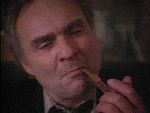| Papers & Essayes |
| The Detective in 'Twin Peaks' by Andreas Blassmann |
3.1. The Formula of the Gothic
Gothic elements will also dominate Cooper's story in the second season, with the constant presence of the 'mad Gothic villain' Windom Earle who initiates Cooper's vulnerability (I will attempt to define the term 'mad gothic villain' in 3.3 ). In episode eighteen Cooper reveals first details about the love affair with Caroline Earle (Windom's wife) and the tragic plot that stands in firm connection with Cooper's darker emotional side. This plot development functions mainly as an explanation for the appearance of the Windom Earle character. Earle is Cooper's former mentor and FBI trainer. Earle is introduced into the show in episode ten, when Albert Rosenfield informs Cooper about Earle's escape from a mental institution. At this point, it already becomes clear that Windom Earle is seeking revenge for past events.25 The term 'Gothic Soap Opera' shall be used in connection with Cooper's love affair and Earle's revenge plot, as it is not so much concerned with the common Soap Opera goings-on in the town of Twin Peaks. The Earle-Cooper-Caroline triangle clearly strives for a recreation of the past, a replay of a tragedy that has already happened. Cooper's love affair with Annie Blackburne, a new character who enters the Soap Opera world in episode twenty-five, is pointing towards a reenactment of past events. I argue that the Gothic in TP is manifested in a revengeful 'return of the past'. Encountering the demonic father figure Windom Earle, Cooper is suddenly faced with his own past and therefore goes through a continuous change from the detective figure, which I analyzed in the first two chapters, into a character who resembles the helpless hero in traditional Gothic stories. It appears as though TP would re-construct a movement from the detective story back to the formulaic pattern of the Gothic.26 In Gothic fiction, the villain is always more powerful and dominant than the hero. William Patrick Day explains that the figure of the detective develops from the tension created by the lack of a true hero. He is, in effect, the hero the Gothic world needs but cannot sustain. The presence of such a character revises the balance and dynamics of the genre, focusing on the restoration or order and meaning rather than on the steady disintegration of identity and the absolute instability of the world in which the characters live. Out of the Gothic fantasy's critique of the romance grows a revised version of the romance, and the romance quest hero returns in the guise of the detective. (Day, 50f.)The FBI Agent Cooper is, in the course of the story, transformed into the ordinary citizen Dale Cooper. He removes his black suit and dresses into the a local color outfit. Thus, even his physical appearance resembles the look of a Twin Peaks lumberjack. His involvement with the townsfolk already dispossessed him from his role as a sole observer. After the solution of the murder mystery, Cooper himself becomes the object of investigation. Cooper even bears parallels to other members of the Twin Peaks populace who have to fight the dominance of a shadowy father figure, e.g. Audrey Horne or Laura Palmer.27 However, the second season offers a fundamental readjustment of the depiction of Cooper; the shift of focus from Laura Palmer's past to Dale Cooper's past signals a number of other changes in both the epistemological and the narrative structures of 'Twin Peaks'. (Nickerson, 272)Nickerson rightly observes that with Cooper's announcement in episode eighteen that he is 'gone fishing' (Lavery, 18.5), the show alludes to the very first lines spoken in the pilot by Pete Martell, just before he finds Laura Palmer's dead body (P. 1). These corresponding lines point to a renewal and a reversal of both the TP plot line and Cooper's character and (his)story. The setting of the story, and the general mystery associated with it, has finally taken over the role of the detective as a central investigator of the narrative. Cooper's reconstruction of Laura's past (and her metaphysical revival in his heuristic dreams) are now replaced by a reintroduction of Cooper's own past: his fatal involvement with Earle's former wife and later his new love interest Annie Blackburne. With a regress to secrets from the past the show seems to leave the detective genre behind, as it finally reveals intimate psychological details from the detective's emotional history; hence the coinage of the term 'Gothic Soap Opera'. Interestingly enough, the retrieval of the past leads, according to Nickerson, to a reversal of the TP plotline, an attempt to move into another direction, paradoxically into the future. From the point of Cooper's confession about the Earle-Caroline plot "TP becomes increasingly removed from the double structure of the detective novel and closer to a purely forward-moving serial narrative. The key, paradoxically, is the introduction of material about Cooper's past" (Nickerson, 274). Here, we encounter a central stylistic means of Gothic narratives, namely that "secrets are always revealed, no matter how vehemently they are repressed" (275). The narrative doubling in TP finds its correspondence in the doubling of characters, another Gothic device that shall be examined in chapter 4.4.
25 The true nature of the Earle-Cooper enmity is revealed in episode twenty-two, when Cooper tells Sheriff Truman about the reasons for Earle's revenge (Lavery, 22. 8): Cooper: Four years ago we [Cooper and Earle] drew the assignment of protecting a material witness in a Federal crime. She was very beautiful. A very gentle woman. Her name was Caroline. She and I fell in love. One night I failed in my vigilance. An attack was made. I wasn't ready. I was wounded and I lost consciousness. When I came to, she was...dead. She had been stabbed. Sheriff Truman: So why is he [Earle] after you? Cooper: Caroline was Windom Earle's wife. Sheriff Truman: So he blames you for her death. Cooper: It's much worse than that, I think he killed her. .. Harry, Windom Earle's mind is like a diamond: cold, and hard and brilliant. I think he feigned the insanity that sent him away. 26 Poe created the detective story as a counterpart to his Gothic tales of terror . It appears as though TP would construct a backwards movement of Poe's detective story to the unsolved mystery stories. Nickerson stresses this point when she adds that "oscillation between the urge to repress knowledge into secrecy and the compulsion to reveal what is concealed is one of the central features of Gothic narrative; in detective fiction that oscillation is largely ... stabilized by the privileging of investigation and resolution." (Nickerson, 273) 27 Just as the "role of the detective seems to have exploded" (Reeves, 185) in the series, meaning that other characters in the show have taken over methods of detection (e.g. Audrey Horne, Donna Hayward or Maddy Ferguson), it is now Cooper's turn to step into the world of the Soap Opera with his relation to Annie and his fight with the villain Earle. Again, the overall confusion of genre in TP shall not be considered here. I am merely concerned with Cooper's shifting role from detective hero to Gothic Soap Opera hero in this thesis.
|
The Detective in 'Twin Peaks' - Content
David Lynch main page
© Mike Hartmann
mhartman@mail.uni-freiburg.de


